How to Print Your Own Book Easily Like a Pro?


Working with a publishing agency can be expensive and slow, you lose a level of control over your book and did we mention its slow? With self-publishing at Ex Why Zed, you get to call the shots, publish faster, and keep more of the profits. Win win win!
Whether you want to print a photography book, novel, local history book, create branded notebooks for your small business, or collect family recipes in a coffee table book, printing your book could be your next project.
So, what are you waiting for? Let's get started on finding how to print your own book easily. We will also guide you through every step, from choosing the right tools to preparing your book for print.
Why is self-publishing the new trend?
In recent years, self-publishing has become very popular. Popular books, such as "The Martian" and "Legally Blonde," were self-published first. Later, they became bestsellers. Authors earn more money with better royalty rates. They also have a chance to get noticed worldwide.
A big plus of self-publishing is that books can stay in circulation forever. Traditional publishers can quickly remove them from the market if sales are low. However, self-published books remain available to readers because they will continue being listed on your own website, feature on your social media and interested readers can find a copy regardless of the timeframe since printing.

What are the perks of printing your book?
Printing your own book has many benefits. First, you have full control over every part of how your book is made. You can choose the trim size, cover design, typography and binding style. Enjoy looking through our portfolio of over 500 previous projects to gain valuable insight and inspiration.
The freedom we give you at Ex Why Zed lets you explore creative designs and formats that big publishers might refuse because they think they are too expensive or complicated to sell. Additionally, using one of our perfect bound book cover templates can make the self-publishing process even more accessible, as it provides a structure for your book and eliminates the need for extensive design work.
Second, you can set your cover price, which traditional authors usually need help with. How much do you want to sell your book for?
Most importantly, self-printing lets you create your book the way you want. At first, this may feel scary, but seeing your ideas become a book that others can read and buy is thrilling. Our vast resources, YouTube videos and account managers can help make this process more accessible than expected. So, if you have a book idea that you've been thinking about, now is a great time to share it with everyone.
Step-by-Step guide to print your own book
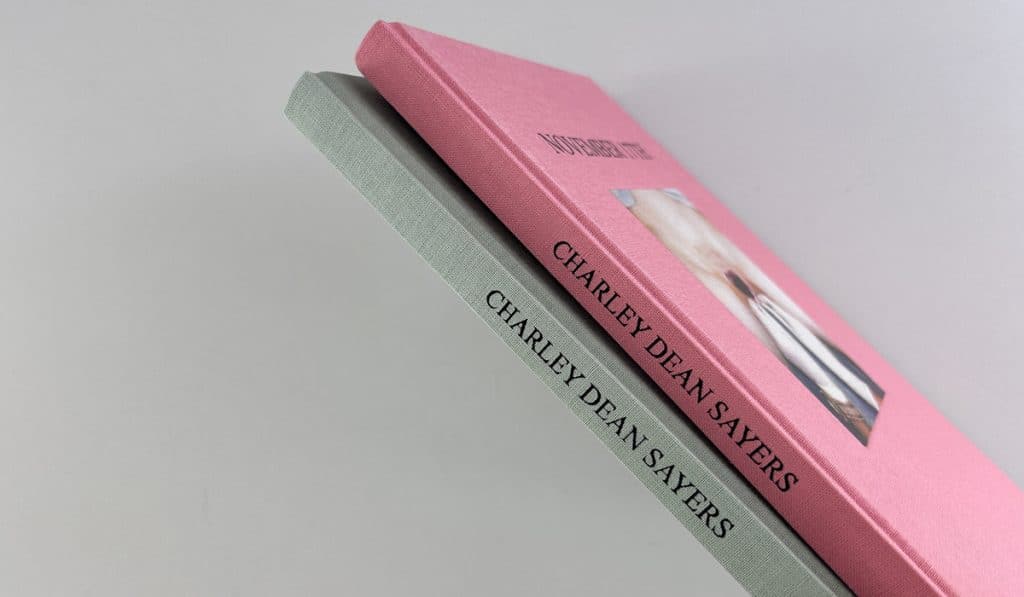
To print your own books that match your vision, you need to carefully select the tools and materials you use. Consider the book's size, the binding style, the type of paper, and the ink options. Even small details, such as the weight of the paper, can affect how your book feels and looks.
For a truly premium look, hardback book printing is a great option to make your book stand out. Each choice should enhance your content, feel good in the reader's hands, and give the book a professional look. Let's look at these critical points closely.
- Designing your Layout
Well-polished content is essential for a good book. Good design promotes professionalism, removes mistakes, ensures consistency, and improves readability. A professional designer has a sharp eye for details. If you're on a budget, consider asking friends or family to proofread, using online editing tools, or getting feedback from beta readers. Read our guide to finding a book designer.
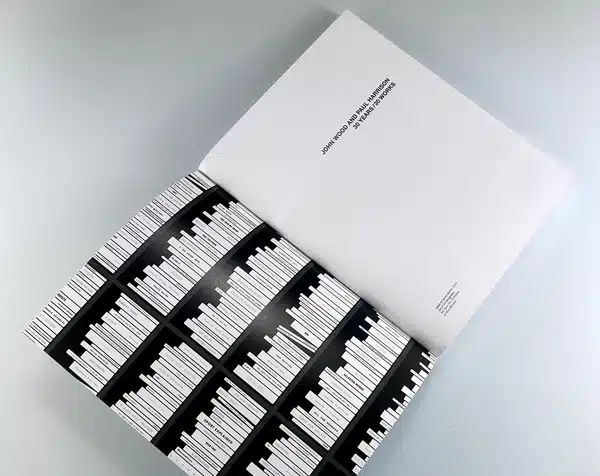
- Selecting a book trim size
The trim size you choose for your book is crucial as it affects how readers handle it. Standard sizes include A5 (148 x 210 mm), A4 (210 x 297 mm), Novel (127 x 203 mm), Standard (132 x 77.5 mm), US Letter (215 x 279 mm), Square (210 x 210 mm) and we print all custom sizes in-between.
To select a book trim size, you must consider your book type. Novels typically use smaller, thicker sizes, while children's books are often larger and landscape format. Selecting the right book size is essential in printing to ensure a professional and reader-friendly final product.
- Paperback vs. hardcover
When it comes to your choice between paperback and hardcover books, consider the cost-effectiveness of paperbacks. They are lighter and cost less to produce, making them a savvy choice for online sales and international shipping.
Hardcovers, also known as hardback books, are considered higher quality and have a sturdy hard cover that protects the inside pages. They work well for coffee table books or items you want to sell at a higher price. Hardcovers could be an intelligent choice if you want to impress clients or aim for libraries. Just make sure to choose what works for your readers and is within your budget.
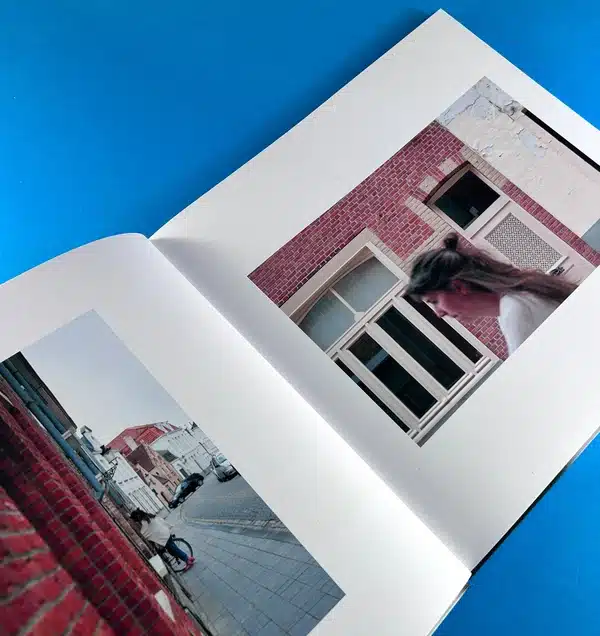
- Binding styles
Binding is combining a book using sheets of paper or other materials. It serves two purposes: it holds the pages together and adds to the book's appearance. Here are some common types:
- Saddle Stitched or Stapled: This is the cheapest choice. It is excellent for smaller books since it can only hold a limited number of pages.
- Perfect Bound: This is the most popular binding style for paperbacks. It gives a clean and professional look.
- Case Bound or Hardcover: This is the standard for hardcover books. It provides strong durability and feels premium.
- Wiro Bound: This is commonly used for notebooks or manuals. It allows the book to fully open and lay flat on a surface, which is very helpful.
5. Paper types and ink options
The kind of paper you choose can change how your book looks, feels, and even smells. You might pick glossy pages when you print your own photo book. For a novel, uncoated paper can make it easier to read.
Ensure your chosen paper type and ink work well with your printing service. This way, your finished book will meet your expectations.
We have both digital and litho machines. Digital is your go-to for under 500 copies, litho is a winner for higher quantities.

6. Choosing a font
Typesetting involves arranging text on each page, which is crucial for readability and visual appeal. It includes selecting the right font, size, line spacing, and margins and organising paragraphs, chapters, headers, footers, and page numbers.
As a guide, a font size of 8-10 is standard for books which are intended at grown up reader. Larger sizes like 16-20 are engaging in children's books where legibility is key and the content per page is more minimal.
Different genres also dictate specific fonts: novels often use Serif fonts for readability, while children's books use Sans Serif fonts for a more straightforward look. Comic Sans is the classic, tongue in cheek choice for books aimed at younger readers.
If you're stuck, looking at other books in your genre can help you get some ideas. We love to look at the design portfolio from renowned worldwide design agency, Pentagram, for book design ideas. If you're going to get inspiration, where better to source it from than the very best.
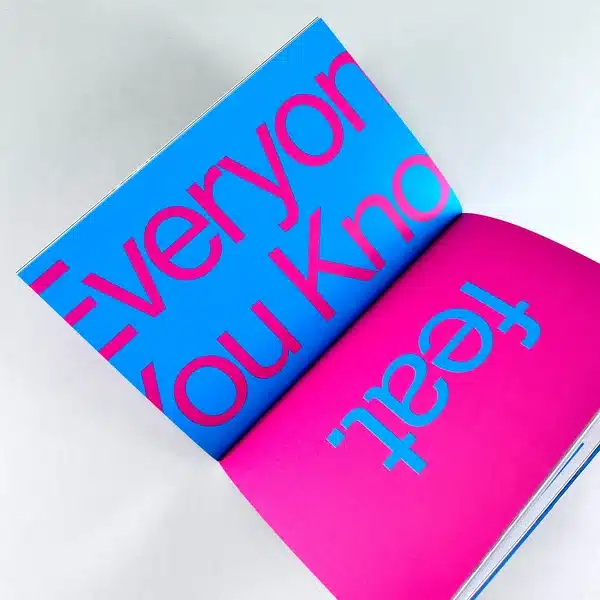
7. Designing your book cover
Your book cover acts like the face of your story and is very important for selling it. A professional cover design from a designer can showcase your work well. It shows what your story is about and helps attract readers. Here are some key points to think about:
- Title & Author Name: Make sure these are easy to read and stand out.
- Imagery: Use relevant pictures that suggest what your book is about.
- Typography: Select font sizes matching your book's style and genre.
- Colour Palette: Choose colours carefully to set the mood.
8. Print finishes
From a feel perspective, the finish of your print book is just as important as how it looks. Choose gloss lamination for a shiny look or matt lamination for a smooth feel.
Other finishes include spot UV for shiny accents and embossing for raised or lowered designs. These touches can make it stand out but may require more time and money. Select a finish that complements the feel of your book and the impression you want to leave on readers.
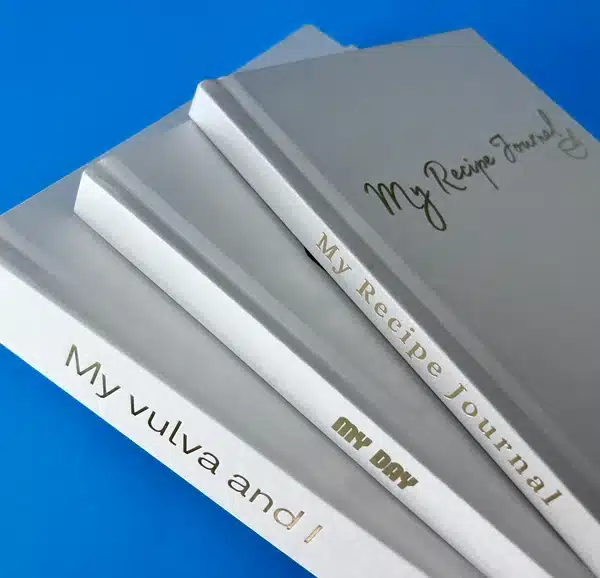
9. Preparing your files
Once you have edited your text, set it up, and are done with your cover design, you must prepare your files for printing. Most printers want your files in PDF format. This type keeps your layout and page design intact.
Ensure all images are at least 300 DPI for clear print quality. It's a good idea to embed fonts in your PDF file. Use CMYK colour to get the best results. Your cover file should include the front cover, back cover, and spine all on one spread.
If your book is perfect bound or hardcover, don't forget to add the spine to your design. Lastly, include bleed and quiet areas as your printer requests to account for slight changes during printing.
10. Review proof copies
We can produce a physical proof (sample copy) first of your print spec. Our physical proof copies are charged at our cost price to produce (includes labour, materials and set up) We don't make any profit from the price we charge at this stage.
This first copy will be good for you to check the layout and overall feel of the book and then you can make all the necessary changes to the files before the final print run, just to advise however these will not be colour matched to the final print run. What we mean is, we won't have a press minder matching the print pixel for pixel to the printed proof when we come to print the final books.
Take your time with the review process for any book. Carefully check each page for formatting issues, ensuring that images and text align properly. Check the print quality to ensure vibrant colours and clear text. You must also verify that the page count and spine width meet requirements. Finally, review the proof's overall appearance to ensure it reflects the professionalism you want for your final product.
What are the Ins and Outs of Printing

- Traditional vs. print-on-demand
There are two main printing methods: traditional printing and print-on-demand. Traditional or offset printing is cost-effective for large print runs and offers better colour quality. It's ideal for high demand.
On the other hand, print-on-demand books are printed when ordered, saving on storage and reducing initial costs. They also allow for easy content updates. Although they're more expensive per book, they eliminate concerns about unsold inventory. Print-on-demand is a good entry into the market for self-published authors, especially beginners.
At Ex Why Zed, we don't have a minimum quantity so while we can print you one copy at a time, we admit to being much more cost-effective if you print more copies at a time.
- Environmentally friendly printing techniques
As sustainability grows in importance, many publishers are adopting eco-friendly printing methods. These methods include:
- Using eco-friendly inks: Inks made from soy and plants are better for the environment than those made from oil.
- Choosing FSC® certified paper: This label means the paper is from forests that are cared for responsibly.
- Opting for digital printing methods: Digital printing creates less waste because it needs fewer chemicals and makes less scrap.
- Implementing energy-efficient practices: Many printing companies are working to save energy, which helps lessen their impact on the environment.
- Our litho printed jobs are printed using vegetable inks.
- Reviewing your proofs like a pro
Before your book is entirely made, reviewing the proof is very important. A hard copy proof is a sample copy that shows how it will look and feel. It allows you to make last-minute changes to avoid costly mistakes, check colour quality, and ensure images print correctly. Use this opportunity to catch any remaining errors or typos. Though it takes time, it ensures your book meets your expectations and reflects your hard work.
A soft proof is included with 95% of our projects. This is free and allows you the confidence of one last opportunity to check the artwork on screen before approving it for printing.
Use Ex Why Zed
For many authors, printing a book can feel too much. There are high costs involved, and tricky processes can worry you to no end. They need a simple and low-cost way to print books.
Ex Why Zed is here to help if you're struggling with book printing issues. Our platform offers affordable and customisable high-quality printing services, which you can kickstart with a simple setup and expert guidance from professionals who have been in the business for years. It has a simple setup, too, so you can focus on your writing.
Moreover, our support team is ready to help you at every step. We thoroughly pre-flight every job that arrives with us. It will be checked by an actual human who is an expert in file set-up and the intricacies of printing. If everything needs changing, we will then come back to you and you have the opportunity to make changes before the job goes anywhere near our presses.
We take great pride in helping people transform their work into print.
Want to get started? Get in touch with us here.
Conclusion
With self-publishing at Ex Why Zed, you have total control over how your book looks, how much it costs, and how it gets shared. This option lets you break free from traditional publishing and brings your unique ideas to life just as you see them. It takes time, effort, and patience. However, seeing your thoughts in print and reaching readers worldwide can feel amazing.
With numerous resources, tutorials, and services available, you can print your book regardless of your experience level or budget. Keep our illustrated guide close as you start this journey. Remember, each book you print helps you grow as an author. So, get ready, make your choices, and turn your manuscript into the book you dream of!
Frequently Asked Questions
Can you print your own book on a home printer?
While it is possible to create and print your own book using a home printer, it is not usually a good choice for a book that looks professional. It would be a lot of hassle and very much like a cottage industry. Desktop printers do not have enough options for paper, ink, and binding, which are important for making high-quality books. You would also need binding machinery which might not fit on the kitchen table 🙂
How much does it cost to print your own book?
The cost to print your book varies based on several factors. These include the number of pages, trim size, binding style, paperweight, and ink quality.
Are there any legal issues with self-publishing?
Self-publishing is legal if you publish original content and follow copyright laws. It's wise to check and understand the legal rules and risks in your country or area.
Where do I get an ISBN Number from in the UK?
For the ISBN you should go directly to https://www.nielsenisbnstore.com/ who are the UK suppliers. On their site, you secure the ISBN, then download the barcode which can be added to your artwork.
What is the best platform for selling my self-published book?
You can sell your self-published book on several platforms. These include big online stores like Amazon and Barnes & Noble - these have huge exposure but do take a percentage from sales. You can also use your author's website and social media. The best platform for you will depend on your target audience's likes and how you want to market them.
Can I preview my book before it goes to print?
Yes, we can send you either a hard copy proof (for a charge) or a soft proof PDF (for free). You can ask for your physical or digital sample before it is printed. This way, you can check everything. You can look at colour quality and formatting. It helps you make any changes needed before the final printing.

